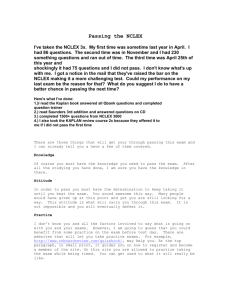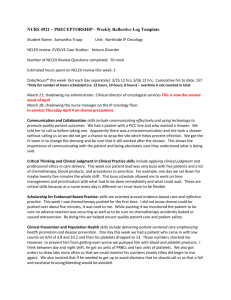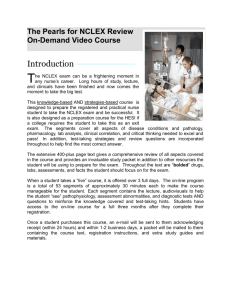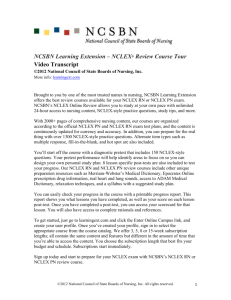File
advertisement
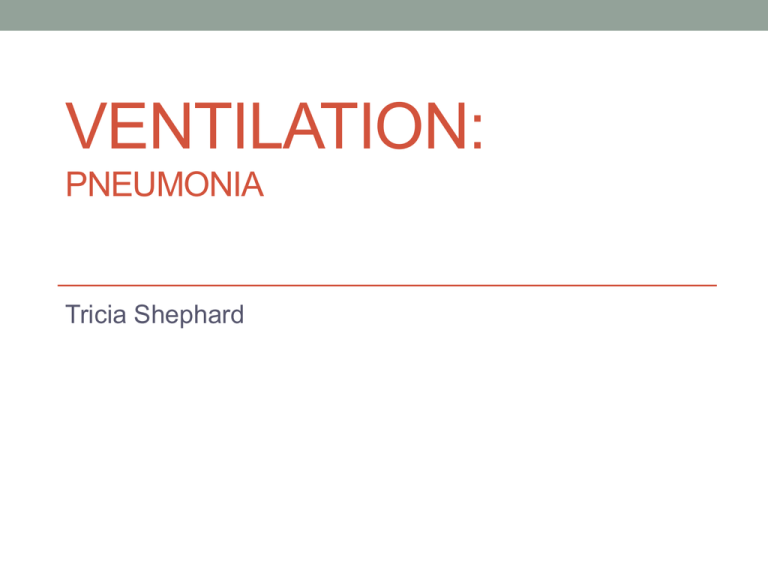
VENTILATION: PNEUMONIA Tricia Shephard Ventilation The movement of air between the environment and lungs through the inhalation of oxygen and exhalation of carbon dioxide. Gas exchange: the process by which oxygen is transported to the cells and carbon dioxide is transported from the cells. Occurs in the alveoli Hemoglobin carries the inhaled oxygen to the cells for metabolism and to perfuse to the various tissues of the body. Risk Factors for Altered Ventilation Populations at Risk: Infants – Less alveolar surface area available for gas exchange; Fetal hemoglobin stores which only last for approx. 5 months and result in shorter RBC lifespan Elderly – Anatomic and physiologic changes associated with advanced age Individual Risk Factors: Air pollution Tobacco use Allergies Prolonged immobility Chronic disease Infection Conditions Altering Ventilation Non-Pulmonary Conditions CHF Congenital Heart Defects Trauma/Paralysis Obesity Anemia Pulmonary Disorders Atelectasis Decreased surfactant production Restrictive disorders Pneumothorax Blood or fluid in the pleural space Obstructive Disorders Asthma Bronchitis Emphysema Foreign body obstruction Patient Application: Pneumonia Clinical Manifestations: Presented to the ER with complaints of fatigue, rapid heart rate, rapid respirations, fever, SOB, and harsh cough. Chest X-Ray and CT completed Found dense L lower lobe consolidation with small bilateral pleural effusions Diagnosis: Sepsis related to pneumonia Assessment Patient’s Vitals upon Admission: HR 118 RR 22 Temp. 103.1˚ BP 133/63 SPO2 90% Respirations shallow, labored with unproductive cough SOB Breath sounds were diminished in bilateral lower lobes, with crackles in bilateral upper lobes Patient unable to clear secretions S1S2 Regular Oriented x 4 Extremities warm and pink Pulses 2+ bilaterally Experiencing intermittent fever Localized edema in legs and scrotum Labs Abnormal: WBC High 12.0 RBC Low 2.94 Hemoglobin Low 8.8 Hematocrit Low 27.6 MCHC Low 31.0 RDW High 16.2 PT High 13.6 Ca Low 7.8 CO2 High 32 Iron Low 31 TIBC Low 123 Ferritin High 2,780 Patient also found to have a history of anemia, altering many of the lab values along with his diagnosis of sepsis related to pneumonia. Interventions Diagnostic Studies: Found by the Journal of Primary Health Care as the most definitive: Chest X-Ray CT Sputum Sampling Assessment Monitor respiratory status (rate, depth, pattern, breath sounds) Quality of cough and clearing of secretions Look for changes in mental status Watch for perfusion issues/cyanosis Interventions Oxygen therapy Pharmacologic Therapy Antibiotics Mucolytic Expectorant/ Antitussive Perform pulmonary hygiene Encourage incentive spirometry Encourage cough and deep breathing Interrelated Concepts Anxiety Acid-Base Balance Perfusion Nutrition Mobility Fatigue NCLEX Questions In order to prevent ventilator associated/ acquired pneumonia (VAP) in an intubated patient, the healthcare provider should: A) Provide oral care and suctioning to the patient B) Maintain intubation for no more than 72 hours C) Give prophylactic antibiotics D) Discourage patient visitors NCLEX Questions Answer: A Providing oral care and suctioning the airway is an important intervention in order to prevent VAP. The patient should be repositioned at least every 2 hours and assessed for readiness to be weaned from the ventilator as soon as safely possible. Prophylactic antibiotics are not recommended. NCLEX Questions Which of the following is a normal finding when assessing the respiratory system of an elderly client? A) Decreased mobility of the thorax and increased chest wall stiffness B) A decreased anteroposterior diameter and increased alveolar surface C) Bronchovesicular breath sounds throughout the lungs D) Increased thoracic expansion and relaxation of elastin tissues NCLEX Questions Answer: A The normal aging process is accompanied by physiologic changes to the respiratory system such as stiffening of elastin and collagen tissues, increased alveolar diameter, decreased alveolar surface, and increased chest wall stiffness. Bronchovesicular breath sounds are heard over major bronchi where fewer alveoli are located. NCLEX Questions When an elderly person is hospitalized with pneumonia, what would be the best action by the nurse to encourage eating? A) Provide small, more frequent meals. B) Secure an order for a daily multivitamin to stimulate appetite. C) Provide a high-calorie snack of the client’s choice. D) Make sure the client is adequately hydrated. NCLEX Questions Answer: A An elderly person is more likely to eat if portions are small, more frequent, and nutrient-dense, as opposed to a full meal tray three times a day. A vitamin will not stimulate appetite. Snacks are not necessary if small, frequent meals are provided. Hydration is always important, but fluids do not provide the nutrients needed for healing. NCLEX Questions A diagnosis of pneumonia is typically achieved by which of the following diagnostic test? A) ABG analysis B) chest x-ray C) blood cultures D) nutritional intake NCLEX Questions Answer: B The major diagnostic tests used to identify the extent of the lung tissue affected by pneumonia is chest x-ray and to identify the causitive agent is sputum culture and microscopy. NCLEX Questions A patient has been hospitalized with pneumonia and is about to be discharged. A nurse provides discharge instructions to a patient and his family. Which misunderstanding by the family indicates the need for more detailed information? A) The patient may resume normal home activities as tolerated but should avoid physical exertion and get adequate rest. B) The patient should resume a normal diet with emphasis on nutritious, healthy foods. C) The patient may discontinue the prescribed course of oral antibiotics once the symptoms have completely resolved. D) The patient should continue use of the incentive spirometer to keep airways open and free of secretions. NCLEX Questions Answer: C It is always critical that patients being discharged from the hospital take prescribed medications as instructed. In the case of antibiotics, a full course must be completed even after symptoms have resolved to prevent incomplete eradication of the organism and recurrence of infection. The patient should resume normal activities as tolerated, as well as a nutritious diet. Continued use of the incentive spirometer after discharge will speed recovery and improve lung function. References Galanes, S. (n.d.). EHS: Nursing Diagnosis Care Plans, 4/e - Gas Exchange, Impaired - Ventilation or Perfusion Imbalance. Retrieved November 18, 2014, from http://www1.us.elsevierhealth.com/MERLIN/Gulanic k/archive/Constructor/gulanick23.html Giddens, J. (2013). Concepts for nursing practice. St. Louis, Mo.: Mosby/Elsevier. Lieberman, D., Shvartzman, P., Korsonsky, I., & Liebennan, D. (2003). Diagnosis of ambulatory communityacquired pneumonia. Scandinavian Journal Of Primary Health Care, 21(1), 57.


